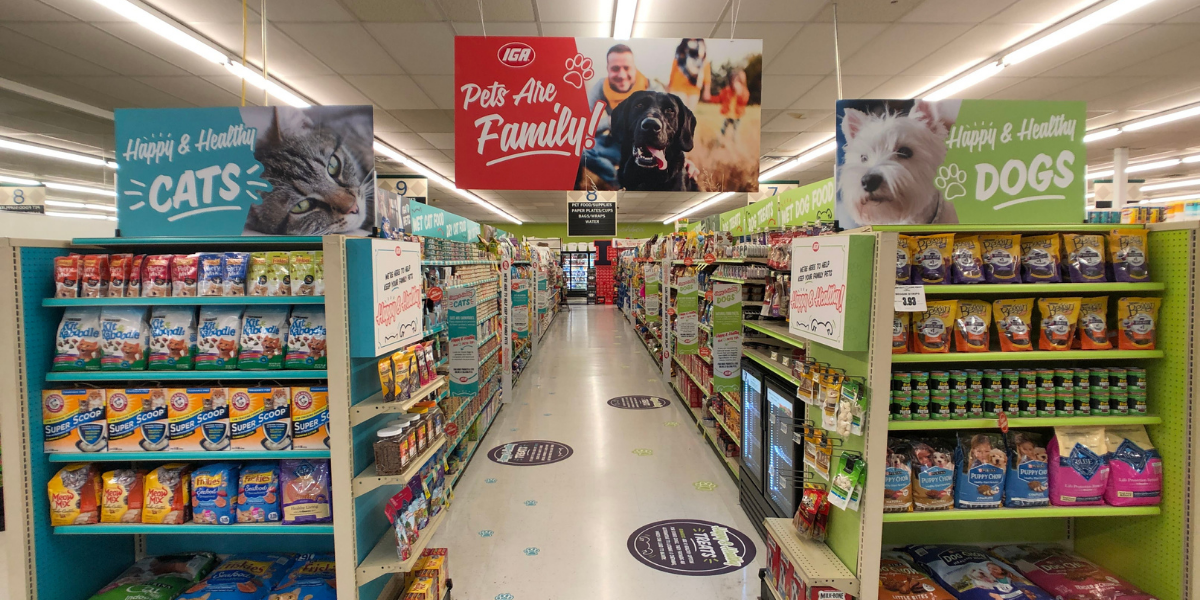Help Isom IGA recover from devasting floods

8 min read
Illinois IGA Pet Aisle Redesign Bumps Category Sales Up 10%
Written by Jessica Vician
Apr 14, 2021
When longstanding IGA owner Brooks Marsh volunteered his Illinois store in 2019 to be the prototype for the IGA-Nestlé Purina pet aisle redesign, sales were down throughout center store—including the pet category—by about half a percent. Recognizing that Marsh's 39,000 square foot store was located in a large millennial market with young families who have pets, the IGA and Nestlé Purina teams jumped at the chance to use the store as an example of what any IGA can do both in pet and in other center store categories by applying a few best practices in assortment, visual merchandising, updated signage, and marketing to the aisle.
“This is not just a model on how you improve the pet category; it’s a model on how you improve every aisle in your store,” IGA CEO John Ross said. “It’s a step-by-step process that begins with, ‘How do you win?’”
"We weren't intentionally ignoring center store, but we were complacent and accepted that we weren't winning there," said Brooks Marsh. Watch Marsh and John Ross detail where the store was before the pet aisle redesign.
As soon as Nestlé Purina Category Team Leader Pat Patterson entered the store's pet aisle, he saw quick fixes the store could make in their assortment and in merchandising that would make it easier for shoppers to find what they're looking for. For example, using an endcap to serve as a navigation cue to the pet aisle, or using eye-level space to introduce premium products.
Watch Pat Patterson and John Ross discuss the assortment and merchandising opportunities.
With the tips Patterson and the Nestlé Purina team shared, this pet aisle redesign didn’t require ripping out shelves or an expensive remodel. “This is what happens when you apply science to center store,” said Ross. By evaluating the store’s category data, the team determined the right assortment of products for their shoppers’ needs and paired it with a better use of the existing space through remerchandising and IGA's new Happy & Healthy Pets visual merchandising signage.
That's what this pet aisle redesign can do: without any extra advertising, retailers can grow margin simply by changing their assortment and updating their visual merchandising and signage, which begins a new relationship with the shopper around pet health.
Our prototype store did just that, and the results prove it: in three months without any additional promotions outside of the norm, sales in pet increased 10.5 percent, with wet cat up 20 percent, cat treats up 28 percent, and cat litter up 53 percent.
Since then, IGA has put these tactics into action in other IGA stores, where we continue to see improvements in comp sales, margin, and other key metrics.
Let’s take a deep dive into this pet aisle redesign to learn exactly what IGA, Nestlé Purina, and the Illinois IGA store did and how all IGA retailers can apply these practices to their pet and other center store aisles and categories for increased sales.
Use data to improve assortment
The Nestlé Purina team, Marsh, and his wholesaler reviewed the store's community demographics, existing pet category sales, nearby pet store competition, and current pet aisle square footage to determine the best assortment for the market. For example, with several big-box pet stores within 10 miles of the store, many of the shoppers buying pet at the store were making fill-in trips, meaning they weren't seeking specialty products like treats and toys. With that knowledge, it made sense for the store to stock more food, bigger bags, and better variety, while slightly reducing inventory of treats, toys, and add-on products. That said, Patterson also noted that it's important to keep an eye on assortment over time. As the IGA store's efforts begin to payoff and it becomes known for their pet department, assortment needs will likely expand.
Knowing what assortment was best for this store, the Nestlé Purina team drew up a plan that used the IGA store’s existing pet aisle space more efficiently by adding shelves and moving products into locations that made it easier for customers to shop. In fact, they were able to add 20-30 percent more products in the same amount of space.
Alert & educate shoppers with signage
Making it easier for shoppers is key to the store's success, and alerting them to the changes via signage is a big part of it. "Starting with the welcome message, we are streamlining the journey and letting the shopper know the store has pet care and they are here to play," Nestlé Purina Account Manager Kara Destro said.
The signage also made it easier for those shoppers to find what they were looking for, thanks to color-coded areas specific to dogs and cats. A few fun yet helpful paw print navigation decals on the floor made the aisle a destination for families, with kids hopping from print to print and shoppers spending more time in the aisle.
Using color cues and imagery, the signage makes it easy—and fun—for shoppers to navigate the aisle.
But the real benefit of the signage comes down to educating the shopper with tips and facts that help the shopper feel smarter about the way they care for their pets.
"The nature of how we feed our pets has changed," Ross said. "When I was growing up, it was a commodity decision. Today, shoppers have the same health concerns for their pets that they do for any other family member. They want a customized nutrition plan they can feel confident is the best option for their pet. And that's where the average grocery store is missing out. We have product on the shelf, but no assistance or information to help guide them about their decisions."
While these educational signs were created with the help of Nestlé Purina's expert team, Ross noted the content—which features insights on everything from feeding finicky cats to keeping senior dogs physically and mentally healthy—is completely unbranded. That means the shopper gets the unbiased information they need to keep their pets healthy and happy, no matter what brand the shopper chooses for their pet care needs.
It's a formula that pays off for everyone in the long run. "Those happy and healthy pet tips on the aisle blades deliver in-aisle knowledge to shoppers so they can make the right decision for their pet—which just so happens to help the retailer, too," Destro said. As Ross pointed out, "When a shopper starts doing what is best for the health and happiness of the pet, they generally move to a more premium product—it's better for the pet and also a higher price point, which means we make higher margin on those items. Everyone wins."
And when those signs combine with online content like articles, blogs, and videos on IGA.com, IGA retailers' websites, and their social media pages, it's easy to see how over time, IGA retailers can become known as the pet authority in their marketplace.
Destro and Ross share why shopper education is so important for loyalty and basket size.
Highlight assortment with updated visual merchandising
In determining where to place the signage and their updated assortment, the IGA store followed these visual merchandising best practices as recommended by Destro.
- Use your space efficiently. Add shelves and pusher racks, and move products into locations that make shopping easier.
- Maximize margin and trade-up opportunities. Lead with ultra-premium products, then premium, then value, etc. within all categories. Show the best product first, since shoppers who want that product will find it anyway.
- Boost single-basket sales by cross-merchandising. Use data trends to determine the best options for cross-merchandising. For example, Nestlé Purina’s data shows that wet cat food shoppers tend to buy more cat treats, so put cat treats next to wet cat food.
- Position profit-boosting items at eye level, on end-caps, or in POP kit displays.
Watch Destro share important merchandising tips for the pet aisle with John Ross.
While data from the initial discovery led Nestlé Purina to recommend the store stock fewer specialty products like treats in favor of bigger bags, that doesn't mean treats were abandoned entirely. In fact, Patterson and the team saw an opportunity to pick up more sales with fewer products by using some clever merchandising tactics.
Before the aisle redesign, the store had placed cat treats next to dry cat food. But Nestlé Purina’s data showed that shoppers who buy wet cat food tend to buy more cat treats. After the redesign, the store placed wet cat and food and cat treats next to each other, resulting in cat treats up 28 percent and wet cat up 20 percent. Both subcategories increased thanks to a smart cross-merchandising approach.
What changed?
Beginning with data and ending with a full aisle refresh, the IGA store saw firsthand how a few smart, thoughtful changes—instead of an expensive store remodel—can impact the pet category. "The success of this pet aisle redesign proves that given the average budget of an average IGA store in a medium to smaller set, it is still possible to win," Ross said.
There was no need to expand the size of the pet aisle, as they used the space more efficiently. They still increased the assortment variety in the existing pet aisle by adding shelves in certain segments, pusher racks in treats, and moving products into locations that make it easier for shoppers to shop. The updated signage keeps it simple and easy for the customer to shop. Now shoppers see an organized aisle that makes it easy to find what they need and easy to locate add-ons that help the retailer’s bottom line.
From there, the store has many opportunities to take their pet category further, tying it in with the local community through the veterinary school at nearby University of Illinois and the local Humane Society. Destro suggested staging a Pet of the Month end cap featuring a photo of the pet with a favorite treat.
Those local ties make these categories fun and rewarding for retailers, Ross said. "It's easy to get caught in the trap that 'I'm in the business of moving boxes and cans,'" he said, likening that mentality to operating a Walmart or dollar store. "But if you rethink the strategy that 'My mission is to make your pet happier or healthier,' and deliver information and a better shopping experience to make that true, now you can get more creative."
Marsh and Ross break down the details on every change in the pet aisle.
The results
"The consumer won, so we won, and our sales are great!" Marsh says. Specifically, the results show significant growth:
- 10.5% increase in pet department sales
- 35 SKUs added without changing the aisle's footprint
- 53% increase in cat litter
- 28% increase in cat treats
- 20% increase in wet cat
- Selling more premium products
- Unit & transaction sales are up
Of the pet department sales increase of 10.5 percent Ross said, "You're making a lot more money in the same exact square footage." He and Marsh were especially impressed by the difference the visual merchandising made, noting the 53 percent increase in cat litter sales. "We didn't do anything to cat litter—we just remerchandised it," Ross said. "That tells you you're growing share and people are shopping your aisle for the pet category that they wouldn't have shopped before."
Get the full report of the results from Destro and Ross.
According to Ross, this pet aisle redesign is more than what it seems. It’s not just about pet, but about center store. “If we can redeploy the insights our manufacturing partners have inside an IGA store, we can prove that IGA doesn’t have to participate in the sliding scale in center store. Because it worked so well, we're now applying that same process to other key categories like baby, beer, and cereal, which means we're building a full center store strategy to help retailers increase sales and win."
Next Steps
Ready to boost pet sales and attract loyal pet shoppers? Let's get started.
- Order the Pet Signage kit, which will arrive with a playbook that tells you where to install the signs and gives you visual merchandising tips.
- If you're planning a full aisle refresh, contact Nestlé Purina's Kara Destro, who can analyze your current sales and make optimal assortment recommendations by working with your wholesaler.
- If you want to start with small changes, use the tips outlined in this story to update your assortment and improve your visual merchandising. Plus, use the instructions included in the Pet Signage Kit along with the online content to establish your store as a pet care destination.
Previous Story
← A Tribute to IGA Retailer Richard Scheck
You May Also Like
These Stories on Red Oval Roundup
Apr 9, 2024 9:01:07 AM |
2 min read
Apr 3, 2024 1:55:57 PM |
3 min read




No Comments Yet
Let us know what you think